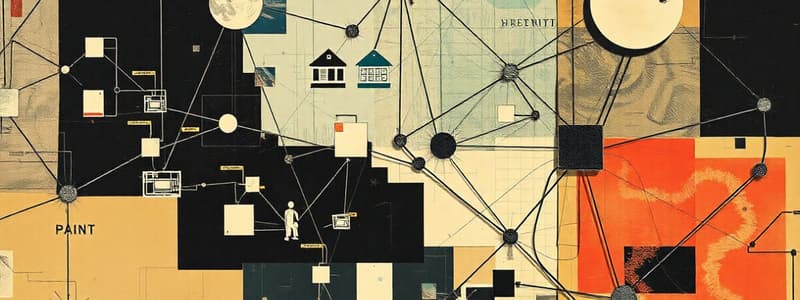Podcast
Questions and Answers
What is one advantage of Multiprotocol Label Switching (MPLS)?
What is one advantage of Multiprotocol Label Switching (MPLS)?
- Complex configuration
- No data prioritization
- High redundancy in case of link failure (correct)
- Increased physical cabling requirements
What does mGRE stand for?
What does mGRE stand for?
Multipoint Generic Routing Encapsulation
Client-server networks are more organized than peer-to-peer networks.
Client-server networks are more organized than peer-to-peer networks.
True (A)
Which network architecture is characterized by equal authority among connected devices?
Which network architecture is characterized by equal authority among connected devices?
What is a primary drawback of bus topology?
What is a primary drawback of bus topology?
Match the following topologies with their characteristics:
Match the following topologies with their characteristics:
A star topology configuration is less fault-tolerant than a bus topology.
A star topology configuration is less fault-tolerant than a bus topology.
A ___ topology has a direct connection between two devices.
A ___ topology has a direct connection between two devices.
What is one limitation of a mesh topology?
What is one limitation of a mesh topology?
Which of the following are network topologies? (Select all that apply)
Which of the following are network topologies? (Select all that apply)
A local area network (LAN) typically spans multiple geographic locations.
A local area network (LAN) typically spans multiple geographic locations.
What is the primary purpose of a router in a network?
What is the primary purpose of a router in a network?
Which device primarily provides access to resources on a network?
Which device primarily provides access to resources on a network?
The term ______ refers to any device on the network that can request access to resources.
The term ______ refers to any device on the network that can request access to resources.
What distinguishes a server from a workstation?
What distinguishes a server from a workstation?
Which of the following describes a wide area network (WAN)?
Which of the following describes a wide area network (WAN)?
Match the following server types with their functions:
Match the following server types with their functions:
A storage area network (SAN) can carry general network traffic.
A storage area network (SAN) can carry general network traffic.
What does a metropolitan area network (MAN) typically cover?
What does a metropolitan area network (MAN) typically cover?
Which topology consists of a succession of connections between one router and multiple destination routers?
Which topology consists of a succession of connections between one router and multiple destination routers?
What does hybrid topology mean?
What does hybrid topology mean?
A _____ is a network typically found in your home or workplace.
A _____ is a network typically found in your home or workplace.
A _____ connection connects your home or workplace to the Internet.
A _____ connection connects your home or workplace to the Internet.
A _____ topology is also known as a hub-and-spoke topology.
A _____ topology is also known as a hub-and-spoke topology.
The term ____ is used to describe the service-related entry point for a provider.
The term ____ is used to describe the service-related entry point for a provider.
The ______ ______ model is used to condense the core and distribution layers into one layer.
The ______ ______ model is used to condense the core and distribution layers into one layer.
Fault tolerance is not a key consideration when designing a network.
Fault tolerance is not a key consideration when designing a network.
What is the backbone of a network?
What is the backbone of a network?
What type of network allows for very fast switching in data centers?
What type of network allows for very fast switching in data centers?
Which layer in the three-tier model is responsible for connectivity between geographic areas?
Which layer in the three-tier model is responsible for connectivity between geographic areas?
East-west traffic refers to data flowing to and from your internal network to the outside Internet.
East-west traffic refers to data flowing to and from your internal network to the outside Internet.
A _____ is a virtualized piece of hardware that connects the virtual machine operating system to the network.
A _____ is a virtualized piece of hardware that connects the virtual machine operating system to the network.
Fibre Channel is typically found inside a _____.
Fibre Channel is typically found inside a _____.
The term used to reference the smallest piece of the network is ______ ______.
The term used to reference the smallest piece of the network is ______ ______.
The _____ technology uses labels to switch traffic.
The _____ technology uses labels to switch traffic.
The _____ _____ architecture is found in data centers to provide low-latency connectivity to servers.
The _____ _____ architecture is found in data centers to provide low-latency connectivity to servers.
Which network type is locally owned and managed by an organization and used to connect the organization's LAN together?
Which network type is locally owned and managed by an organization and used to connect the organization's LAN together?
Which network topology design has a centralized switch connecting all of the devices?
Which network topology design has a centralized switch connecting all of the devices?
Which protocol can be typically found inside a PAN?
Which protocol can be typically found inside a PAN?
When computers are logically grouped on a LAN based upon a functional department in the organization, what is the group called?
When computers are logically grouped on a LAN based upon a functional department in the organization, what is the group called?
Which is the primary benefit to using a star topology?
Which is the primary benefit to using a star topology?
What type of logical connection does MPLS create to connect networks together?
What type of logical connection does MPLS create to connect networks together?
Which type of network is used exclusively for storage traffic?
Which type of network is used exclusively for storage traffic?
Which type of traffic flow is routed from your internal network to the Internet?
Which type of traffic flow is routed from your internal network to the Internet?
Which topology incorporates some redundancy of equipment and connections to provide fault tolerance but is not completely fault-tolerant?
Which topology incorporates some redundancy of equipment and connections to provide fault tolerance but is not completely fault-tolerant?
Which topology should be selected if you have a central office that needs to communicate with several branch offices for WAN connectivity?
Which topology should be selected if you have a central office that needs to communicate with several branch offices for WAN connectivity?
Which network architecture allows for access or sharing of resources in a network by the same host?
Which network architecture allows for access or sharing of resources in a network by the same host?
Which is the major advantage of client-server network architecture?
Which is the major advantage of client-server network architecture?
You are setting up a network connection that requires redundancy in the event a switch or single link fails. Which topology should you select?
You are setting up a network connection that requires redundancy in the event a switch or single link fails. Which topology should you select?
Where is the full mesh topology commonly seen in the three-tier design model?
Where is the full mesh topology commonly seen in the three-tier design model?
Which connectivity method is used within a small geographic area to connect an organization together?
Which connectivity method is used within a small geographic area to connect an organization together?
Which virtual network element connects multiple VMs together?
Which virtual network element connects multiple VMs together?
When you tether a cell phone to your laptop using wireless, what is this an example of?
When you tether a cell phone to your laptop using wireless, what is this an example of?
What is the term used to describe the common network used to connect multiple network segments at high speed?
What is the term used to describe the common network used to connect multiple network segments at high speed?
What is a smart jack as it relates to WAN connectivity?
What is a smart jack as it relates to WAN connectivity?
Which protocol is used with dynamic multipoint VPN deployments?
Which protocol is used with dynamic multipoint VPN deployments?
Flashcards
Network Topology
Network Topology
The physical or logical arrangement of nodes and connections in a computer network.
Mesh Network
Mesh Network
A network topology where each node connects to multiple other nodes.
Hybrid Network
Hybrid Network
A network combining multiple topologies to optimize performance and functionality.
Star/Hub and Spoke Network
Star/Hub and Spoke Network
Signup and view all the flashcards
Spine and Leaf Network
Spine and Leaf Network
Signup and view all the flashcards
Point-to-Point Network
Point-to-Point Network
Signup and view all the flashcards
Three-Tier Hierarchical Model
Three-Tier Hierarchical Model
Signup and view all the flashcards
Core Layer
Core Layer
Signup and view all the flashcards
Distribution Layer
Distribution Layer
Signup and view all the flashcards
Access Layer
Access Layer
Signup and view all the flashcards
LAN (Local Area Network)
LAN (Local Area Network)
Signup and view all the flashcards
Workstation
Workstation
Signup and view all the flashcards
Server
Server
Signup and view all the flashcards
Host
Host
Signup and view all the flashcards
Router
Router
Signup and view all the flashcards
SDWAN
SDWAN
Signup and view all the flashcards
MPLS
MPLS
Signup and view all the flashcards
MPLS Advantages
MPLS Advantages
Signup and view all the flashcards
mGRE
mGRE
Signup and view all the flashcards
Peer-to-Peer Network
Peer-to-Peer Network
Signup and view all the flashcards
Client-Server Network
Client-Server Network
Signup and view all the flashcards
Network Architecture
Network Architecture
Signup and view all the flashcards
Bus Topology
Bus Topology
Signup and view all the flashcards
Star Topology
Star Topology
Signup and view all the flashcards
Ring Topology
Ring Topology
Signup and view all the flashcards
Mesh Topology
Mesh Topology
Signup and view all the flashcards
Point-to-Point Topology
Point-to-Point Topology
Signup and view all the flashcards
Physical Topology
Physical Topology
Signup and view all the flashcards
Logical Topology
Logical Topology
Signup and view all the flashcards
Fault Tolerance
Fault Tolerance
Signup and view all the flashcards
Point-to-Point Network
Point-to-Point Network
Signup and view all the flashcards
Point-to-Multipoint Topology
Point-to-Multipoint Topology
Signup and view all the flashcards
Hybrid Topology
Hybrid Topology
Signup and view all the flashcards
Network Backbone
Network Backbone
Signup and view all the flashcards
Network Segments
Network Segments
Signup and view all the flashcards
Demarcation Point (Demarc)
Demarcation Point (Demarc)
Signup and view all the flashcards
Three-Tiered Model
Three-Tiered Model
Signup and view all the flashcards
Collapsed-Core Model
Collapsed-Core Model
Signup and view all the flashcards
North-South Traffic
North-South Traffic
Signup and view all the flashcards
East-West Traffic
East-West Traffic
Signup and view all the flashcards
LAN
LAN
Signup and view all the flashcards
WAN
WAN
Signup and view all the flashcards
Spine-Leaf Switching
Spine-Leaf Switching
Signup and view all the flashcards
Wireless Bridge
Wireless Bridge
Signup and view all the flashcards
Leased Line
Leased Line
Signup and view all the flashcards
virtual network interface card (vNIC)
virtual network interface card (vNIC)
Signup and view all the flashcards
Fibre Channel
Fibre Channel
Signup and view all the flashcards
smallest network piece
smallest network piece
Signup and view all the flashcards
MPLS (Multiprotocol Label Switching)
MPLS (Multiprotocol Label Switching)
Signup and view all the flashcards
low-latency connectivity
low-latency connectivity
Signup and view all the flashcards
locally owned network
locally owned network
Signup and view all the flashcards
star topology
star topology
Signup and view all the flashcards
PAN (Personal Area Network)
PAN (Personal Area Network)
Signup and view all the flashcards
workgroup
workgroup
Signup and view all the flashcards
SAN (Storage Area Network)
SAN (Storage Area Network)
Signup and view all the flashcards
Study Notes
Introduction to Networks
- Networks are invaluable in personal and professional life.
- Networks come in various sizes and complexities.
- Proper maintenance is crucial.
Network Topologies, Architectures, and Types
- Mesh: Every device has a path to every other device.
- Hybrid: Combines different topologies.
- Star/hub and spoke: Devices connect to a central point.
- Spine and leaf: High-performance design for data centers.
- Point-to-point: A direct connection between two devices.
- Point-to-multipoint: A single device connects to multiple devices.
- Bus: A single cable connects all devices.
- Ring: Devices connected in a ring.
Common Network Components
- Workstations: Powerful computers used by users.
- Servers: Dedicated computers that provide resources.
- File Servers: Stores and manages files.
- Mail Servers: Manages emails.
- Print Servers: Manages printers.
- Web Servers: Manages web content.
- Fax Servers: Sends and receives faxes.
- Hosts: Devices on a network that can be accessed by others.
Network Types
- Local Area Network (LAN): Connects devices in a limited geographic area (e.g., home, office).
- Metropolitan Area Network (MAN): Connects devices over a city or metropolitan area, often using carrier provider networks and high-speed connections.
- Wide Area Network (WAN): Connects devices over a large geographic area, often using multiple technologies (e.g., public links, routers) and can use different media.
- Personal Area Network (PAN): Connects devices in a very small area (e.g., a conference room).
- Campus Area Network (CAN): Connects devices within a campus or corporate area.
- Storage Area Network (SAN): Connects storage devices to servers, used for storage infrastructure.
Software-Defined Wide Area Network (SDWAN)
- A virtual network architecture.
- Uses software to manage connectivity, devices, and services.
- Software-based management, allowing for quick adjustments.
- Integration of various transport technologies, including MPLS.
Multiprotocol Label Switching (MPLS)
- A switching mechanism that uses labels to forward data.
- Improves network performance.
- Increases physical and logical network flexibility.
Network Architecture
- Peer-to-Peer: All devices have equal roles in the network
- Client-Server: A central server provides resources to client devices.
Network Topology Selection, Backbones, and Segments
- Network Backbone: A central, high-bandwidth network connection.
- Network Segments: Smaller parts of the network that connect to the backbone.
- Choosing the right topology involves cost, ease of installation and maintenance, fault-tolerance, and security.
Service-Related Entry Points
- Demarcation point (demarcation): The point where a service provider's network ends.
- Service provider links: Methods of connecting networks (e.g., DSL, fiber).
Virtual Networking
- Virtualized networking resources.
- Network function virtualization (NFV): Software-defined network functions.
- Virtualized servers and network devices can be housed on a single system.
Three-Tiered Model and Spine and Leaf Model
- Core Layer: High-availability backbone of the network.
- Distribution Layer: Connects the core layer to access layer
- Access Layer: Connects end-user devices.
- Spine: Network backbone; connects leaf switches (highly reliable and scalable).
- Leaf: Connects servers to the spine (provides many ports).
Traffic Flow
- North-South traffic: Data moving to and from the internal network to the internet.
- East-West traffic: Data moving within the network between internal devices or locations.
Summary
- This chapter provides a foundation for understanding network technologies.
- Various network topologies, components, and concepts are discussed.
Studying That Suits You
Use AI to generate personalized quizzes and flashcards to suit your learning preferences.




